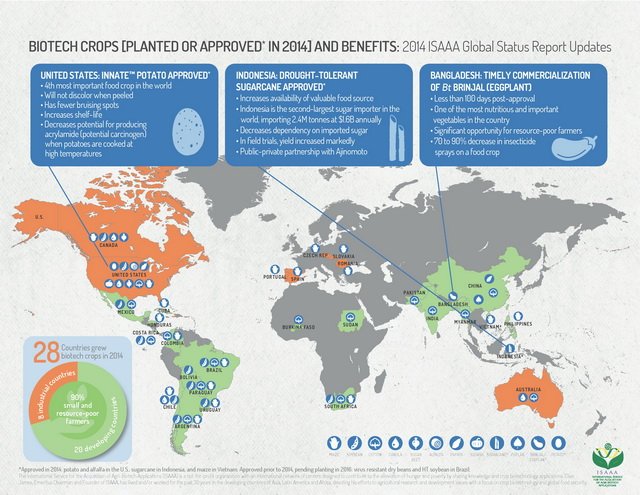ISAAA global biotech crop status report: Asia shows some progress
February 02, 2015 | Monday | News | By Rahul Koul Koul
ISAAA global biotech crop status report: Asia shows some progress
In Asia, China and India continue to lead developing countries growing biotech crops at 3.9 million hectares and 11.6 million hectares planted in 2014, respectively.
A record 181.5 million hectares of biotech crops were planted in 2014, an increase of more than 6 million hectares from 2013 during the 19th year of successful commercialization, stated a report released on January 30, 2015 by the ISAAA.
"The accumulated hectarage of biotech crops grown in 1996 to 2014 equals, roughly, 80 percent more than the total land mass of China," said Clive James, ISAAA founder and report author in a live video message. "Global hectarage has increased more than 100-fold since the first plantings of biotech crops," he added during a press briefing held at New Delhi.
More than 10 food, feed and fiber biotech crops have been approved, planted and consumed around the world during the 1996 to 2014 period. These crops range from major commodities such as maize, soybean, canola and cotton, to crops like sugar beet and sweet corn, and to fruits and vegetables like papaya, squash, sweet pepper, brinjal and, most recently, potato.
According to the report, the United States continues to lead planting at 73.1 million hectares. Up 3 million hectares - a growth rate of 4 percent - from 2013, the United States recorded the highest year-over-year increase, surpassing Brazil, which has recorded the highest annual increase for the past five years.
In 2014, Brazil increased planting of biotech crops by1.9 million hectares to 42.2 million hectares whereas Argentina maintained biotech crops hectarage at 24.3 million hectares. "The world is moving forward in adopting GM crops. There is a new momentum, new hope that India must realize to harness the benefits of this useful technology", said Dr C D Mayee, President, Indian Society for Cotton improvement. "It is high time we catch up with others in extending the technology beyond Bt cotton", said Dr Mayee.
Biotech crops in Asia gain momentum
The adoption rate of biotech cotton in China increased from 90 to 93 percent in 2014, while virus resistant papaya plantings increased approximately 50 percent. More than 7 million small farmers in the country continue to benefit from biotech crops and the latest economic data available indicates farmers in the country have gained $16.2 billion since the introduction of biotech in 1996.
According to the report, India cultivated a record 11.6 million hectares of Bt cotton with an adoption rate of 95 percent. The number of Bt cotton farmers increased to 7.7 million with a substantial increase in cotton planting in 2014. "All of us in Vidharbha grow Bt cotton. We can't grow cotton without Bt technology. For us to be profitable and earn income for our family, we need a new set of seeds to help us control weeds, withstand drought and increase cotton yield to a next level" said farmer Vijay Atmaram Ingle from Akola, Maharashtra.
Over the 13 year period, India tripled its cotton production from 13 million bales to 40 million bales in 2014 and is projected to overtake China to become number one cotton producing country in the near future. British economists Brookes and Barfoot estimate that India enhanced farm income from Bt cotton by $ 2.1 billion in 2013 alone.
Bangladesh successfully began the commercial cultivation of vegetable Bt brinjal and became the 28th biotech crops country in 2014. Biotech crops were planted in 20 developing and 8 industrial countries that represent more than 60 percent of the world's population.
Developing countries Vietnam and Indonesia granted approval for commercialization of biotech crops to begin planting in 2015. This includes several hybrids of biotech maize for importing and planting in Vietnam and drought tolerant sugarcane for planting as a food crop in Indonesia.
The report highlights key benefits of biotechnology, including alleviation of poverty and hunger by boosting the income of risk-averse small, resource-poor farmers around the world. Latest global provisional information for the period 1996 to 2013 shows that biotech crops increased production valued at $133 billion; in the period 1996 to 2012 pesticide use decreased significantly saving approximately 500 million kg of active ingredient. In 2013 alone, crop plantings lowered carbon dioxide emissions equivalent to removing 12.4 million cars from the road for one year.
These findings are consistent with a rigorous meta-analysis, conducted by German economists, Klumper and Qaim (2014), which concluded that GM technology has, on average, reduced chemical pesticide use 37 percent, increased crop yields 22 percent, and increased farmer profits 68 percent during the 20 year period of 1995 to 2014.










